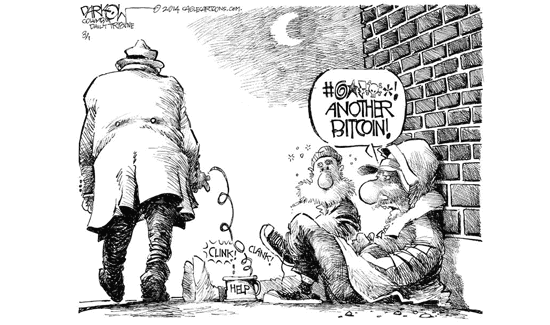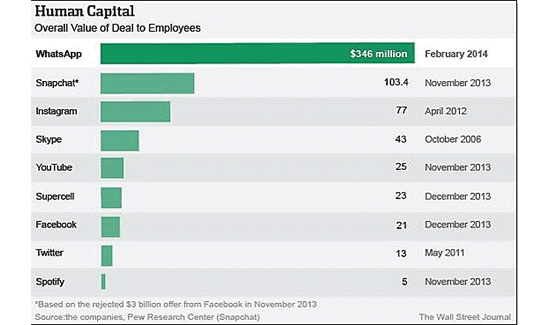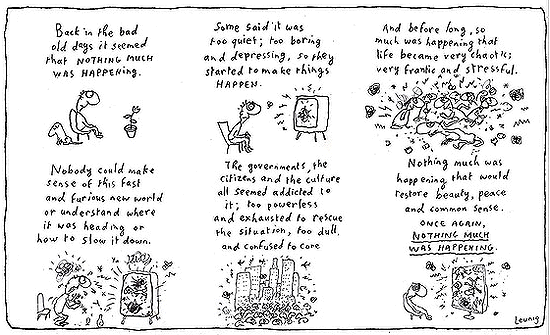
Here's my edition of Top 10 links from around the Internet at 10:00 am today. Sorry about the missing one last week. We now have a Monday-Wednesday-Friday schedule for Top 10.
Bernard will be back with his version this Wednesday. We will have another guest posting on Friday.
As always, we welcome your additions in the comments below or via email to david.chaston@interest.co.nz.
See all previous Top 10s here.

1. The war between Swiss banks and the US tax system
As time goes on and the investigations about banker activity drill down, the details are truly mind-boggling.
HSBC's Mexican operations in laundering drug money has become the stuff of legend - not to mention gaming trade sanctions.
And now Credit Suisse's operations to subvert the US tax system are equal to them, it seems.
The US Senate has been holding hearings. The investigations of a Permanent Subcommittee of senators who oversee Homeland Security have become an angry group after what they found.
On Tuesday the committee had released a 178-page report documenting how Credit Suisse helped US citizens escape taxes using systems which the Republican senator John McCain said were like something out of "a spy novel".
According to the report, bankers filed false visa applications pretending they were tourists and drummed up business at sponsored golf events. One customer's bank statements were passed to him hidden inside a copy of Sports Illustrated.
Clients who visited the bank in Switzerland were whisked to meetings in a button-less, remote-controlled lift where they were advised on the best way to circumvent US tax laws.
About 1,800 Credit Suisse staff worked on the accounts, but only 10 people have been disciplined and none had been sacked, the committee heard.

2. Mike Smith sells
ANZ supremo Mike Smith has sold 36.8% of his shares in ANZ Bank realising some AU$17 million which will partly be used to buy to buy property. (Part will also be used to pay some tax.)
This is interesting in a couple of ways; a bank CEO quitting more than a third of his holding in 'his' bank, and a banker selling high-yielding bank shares to buy property.
I wonder if his property investments will be leveraged with debt? Can't imagine they wouldn't be. Leverage works better with property than shares.
In addition, after the sale Smith also has another 856,000 'performance rights' shares on top of his remaining 932,000 regular shares. He is the highest paid Aussie bank CEO, earning more than AU$10 million in 2013 in 'total remuneration'.
Smith's sell down is a tiny footnote on the issue of banker salaries last week. The main news was from HSBC in Britain: rather than comply with the EU bonus limits, HSBC simply chose to pay its top 600 managers the bonus equivalents as part of their regular salary. Presumably they now don't have to 'achieve' the sort of pre-agreed targets that a bonus system implies.
The Guardian has their spin on the HSBC move, which is a fun read although as it is the Guardian, a spin alert is warranted:
"Dear shareholder, this new EU law capping bonuses is silly so we've decided to exploit the enormous and very obvious loophole. Stuff Brussels: we're not paying ourselves less. Your co-operation in this matter is greatly appreciated."
That was not, of course, how HSBC presented its new remuneration policy and system of "fixed-pay allowances", which will ensure no senior executive is disadvantaged by meddlesome politicians in Brussels. Instead, there was the usual line about the need to remain "competitive" with banks not domiciled in the EU.

3. Serious structural problems
Australia is facing up to some tough choices. Their newly elected Treasurer Joe Hockey has used the world stage to warn that Australia will run out of money for health and education, and must consider unpopular options such as lifting the retirement age to 70, introducing big new taxes, and redesigning the economic system.
''The starting point is, if our health, welfare and education systems stay exactly the same, Australia is going to run out of money to pay for them,'' Mr Hockey said ahead of the G20 forum in Sydney.
''We will either have to have a massive increase in taxes - and that means fewer jobs at the end of the day - or we are going to have to look at ways that we can restructure the system to make it sustainable.''

4. Death to machines?
Even today's Luddite sympathisers have given up trying to figure out how to cope with the next wave sweeping labour these days, the Second Machine Age. Left-wing Lord, professor and provocateur Robert Skidelsky sums up his views like this:
Because computer programs and humans are close substitutes for such jobs, and given the predictable improvement in computing power, there seems to be no technical obstacle to the redundancy of workers across much of the service economy.
Yes, there will still be activities that require human skills, and these skills can be improved. But it is broadly true that the more computers can do, the less humans need to do. The prospect of the “abridgment of labor” should fill us with hope rather than foreboding. But, in our kind of society, there are no mechanisms for converting redundancy into leisure.
But we really need someone to figure out an appropriate public policy response to the changes that are coming. Skidelsky has no idea but I am hoping readers here may spark some options. The issue isn't that we won't adapt. The issue is the speed with which change is coming. We are passing a tipping point that really valuable machine processes (Apps etc) are replacing traditional middle class jobs really fast. Are you ready?
New Zealand may be ok in this process because we don't have the type of manufacturing and service jobs in great numbers that other countries have. But our trading partners (China especially, and the US and Europe) are especially vulnerable.

5. A rethink is needed
The anti-GMO debate has been framed by activists - especially in New Zealand where it has become conventional wisdom - as an ethical issue, and a nature-vs-corporates (Monsanto) debate.
But it is becoming clearer it is an ethical issue, but not the way we have been sold.
Bioethics professor Peter Singer has been grappling with the elements and pointing out Greenpeace has been guilty of playing bumper-sticker politics. (We bought those bumper-stickers years ago.)
Genetically modified crops are now grown on about one-tenth of the world’s cropland, and none of the disastrous consequences that we Greens feared have come to pass. There is no reliable scientific evidence that GM foods cause illness, despite the fact that they receive much more intense scrutiny than more “natural” foods. (Natural foods can also pose health risks, as was shown recently by studies establishing that a popular type of cinnamon can cause liver damage.)
Although cross-pollination between GM crops and wild plants can occur, so far no new superweeds have emerged. We should be pleased about that – and perhaps the regulations that were introduced in response to the concerns expressed by environmental organizations played a role in that outcome.
Regulations to protect the environment and the health of consumers should be maintained. Caution is reasonable. What needs to be rethought, however, is blanket opposition to the very idea of GMOs.

6. A mega payoff
Forget the usual finance metrics: The price Facebook paid for the app Whatsapp last week is being justified in all sorts of new ways. Lets be (un?)real here: they paid US$19 billion for an app, one created by a group of just 35 people in total. Sure, its got millions of users but as yet, no revenue. The Xero folks will have stars in their eyes now.

7. The Aussies love us
Here's a curiosity, especially for those who think a lower exchange rate is a better exchange rate.
Not only are we selling more goods to China (although that can be seen as some sort of special case, given that the goods we sell to other countries are not growing anywhere near as fast), but we are an increasingly attractive place to visit.
Tourist numbers are up strongly, and they are up from Australia, where our currency has appreciated probably the most. Go figure. The percentage growth may be from China as Stats NZ reported, but the annual number growth is from over the ditch (which they didn't highlight). (H/T Infometrics)
(Perhaps our trade balance and visitor numbers will be even higher at one of the parities that are possible these days ? !!)

8. Digital dairy
Despite the pressures, dairy farming is essentially pasture-based in New Zealand - and long may it continue like that. It will be hard; urban consumers demand impact-free produce, free from annoying pictures that can be shown in primary schools and TV (similar places). Buckling from the pasture-base may deliver something those urban school teachers and media novices like even less.
Actually, that is happening in Europe - in fact has been happening for a long time. They get away with it because it is behind closed doors rather than 'outside' near cameras. I vividly recall a visit to Palma in the dairying heartland in Italy. No cows visible, no fences, just beautiful fields of grain crops. But European dairy farmers are in a squeeze with some price supports due to wind down.
Their answer is to either pack it in, or mechanise dramatically. Factory farms include robots; in fact the cows themselves become machines. Spiegel Online has the story:
The radical increase in production per cow in recent decades was primarily the result of improvements in breeding, feeding, milking techniques and care. Those factors hold true for Nielsen on Sylt just as they do for Westrup in Bissendorf, just on a different scale. Both of them, however, are far removed from the extreme limits of dairy farming being tested in North America. The cow of the future in Europe will live in a digital world, milked by robots and fed by machines. In the Canadian province of Québec, some 5,000 kilometers (3,100 miles) away from Nielsen and Westrup, this future is already reality.
There, David Landry stands in his stall and watches as robots do his work for him. A round one, roughly as broad as a hula-hoop, moves between the paddocks shoving the hay closer to the cows. Another machine, the so-called Creeper, crawls through the stalls pushing manure out. In the middle of the stall is the milking robot.
Landry, a small man with thick hands and not much hair, grew up on the farm with his two brothers and remembers back when his father only had about a dozen cows and had to shovel out the manure himself. As a child, Landry milked cows by hand into a bucket. Today, he has 2,300 cows in six huge barns. In the morning, all he has to do is drive the feed to each barn -- the robots take care of the rest. He also has to shove a couple of cows into the milking machine, though most go there on their own.

9. The Far Side at the Fed
The recently published transcripts of the meetings at the Fed have been mined for all sorts of insights - after all it was when the GFC hit.
But the NY Times has also extracted out the humour in those transcripts. A bit corny, as they observe, but fun to read all the same.

10. Today's quote
"Don't gamble; take all your savings and buy some good stock and hold it till it goes up, then sell it. If it don't go up, don't buy it." - Will Rogers
16 Comments
#8 kind of shows that #4 may have a bigger impact on NZ than was suggested above. In particular, in the long term, look at automation of all the white-collar sections of the economy making those no longer financially middle-class.
Easy Hugh.
Just build all the new houses in Dipton and suggest the Australians move there.
Very cheap land and council rates.
:)
cheers
Bernard
According to everyone on this site there are no cheap council rates anywhere
We are indeed, however they are in la la land,
"Myth 2: Peak Oil – there is an imminent shortage of fossil fuel resources
The Reality: There is no shortage in sight."
http://www.worldenergy.org/news-and-media/press-releases/world-energy-c…
Or their stance on Carbon capture a breaktrhough technology, yes it hasnt been done on any scale as yet, deluded.
Its just more BAU, prayers that somehow BAU can continue. Doesnt matter if it comes from the left or right, labour, national, UN or business.
regards
David
#7 is interesting.
The NZ$ has fallen 16% vs the Yuan since peaking at 6.0 yuan in 2005. Over the same time the NZ$ has risen 14% vs US$ and risen 11% on TWI.
Maybe one of the reasons our exports have been so popular in China in recent years is our currency has had a more sensible value.
Just imagine if our currency hadn't been 15-20% over-valued vs the other other currencies, as the IMF/OECD/RBNZ have estimated it has been.
We probably would have had higher interest rates earlier because inflation pressures would have come through.
So maybe we wouldn't have had the housing boom we've seen in Auckland and Christchurch over the last couple of years.
cheers
Bernard
Perhaps on travel, the figures reinforce the exchange rate effects on decisions.
In December 2012 when January travel may have been decided, 1NZD was worth USD 83-84c. By December 2013 1NZD had come off a fraction to US 82-83 cents. Yes the NZD had gone up significantly against the AUD in the same time, but anyone from Aussie contemplating travelling offshore would have had higher costs elsewhere. Throw in the increased costs in AUD terms of longer haul travel, and maybe NZ did win partly on price, given we are close by.
The NZD vs the GBP similarly had come off a tad from 53p to 51p in the same time, just possibly influencing a few more Brits to head south for their winter.
Milk powder I'm sure is bought in USD, so am not sure our exchange rate makes a big difference to the sales volumes or even USD price. It does presumably make a big difference to farmers margins- at least those farmers who still own their farms.
We are passing a tipping point that really valuable machine processes (Apps etc) are replacing traditional middle class jobs really fast.
If this is true the peoiple making these machine processes are going to get rich so one obvious option is to be those people.
The estimates I've seen are for the machine learning algorithms improvement is that it is about 8 years off before the people making the machine processes are themselves automated.
No 5. HEALTH HAZARDS OF GM FOODS - Looks like there are quite a few peer reviewed studies on the health effects. Is Peter Singer disputing the science below?
Earth Open Source - provides the following.
Myth: GM foods are safe to eat
Truth: Studies show that GM foods can be toxic or allergenic
“Most studies with GM foods indicate that they may cause hepatic, pancreatic, renal, and reproductive effects and may alter haematological [blood], biochemical, and immunologic parameters, the significance of which remains to be solved with chronic toxicity studies.” – Dona A, Arvanitoyannis IS. Health risks of genetically modified foods. Crit Rev Food Sci Nutr. 2009; 49: 164–1751
All references are to peer-reviewed studies with the exception of nos. 2, 18 (FDA documents); 3 (scientist’s testimony to New Zealand government); 25 (EU Commission report).
1. Dona A, Arvanitoyannis IS. Health risks of genetically modified foods. Crit Rev Food Sci Nutr. 2009; 49(2): 164–175.
2. Hines FA. Memorandum to Linda Kahl on the Flavr Savr tomato (Pathology Review PR–152; FDA Number FMF–000526): Pathology Branch's evaluation of rats with stomach lesions from three four-week oral (gavage) toxicity studies (IRDC Study Nos. 677–002, 677–004, and 677–005) and an Expert Panel's report. US Department of Health & Human Services. 16 June 1993. http://www.biointegrity.org/FDAdocs/17/view1.html
3. Pusztai A. Witness Brief – Flavr Savr tomato study in Final Report (IIT Research Institute, Chicago, IL 60616 USA) cited by Dr Arpad Pusztai before the New Zealand Royal Commission on Genetic Modification: New Zealand Royal Commission on Genetic Modification; 2000.
4. Prescott VE, Campbell PM, Moore A, et al. Transgenic expression of bean alpha-amylase inhibitor in peas results in altered structure and immunogenicity. J Agric Food Chem. 16 Nov 2005; 53(23): 9023–9030.
5. Malatesta M, Biggiogera M, Manuali E, Rocchi MBL, Baldelli B, Gazzanelli G. Fine structural analyses of pancreatic acinar cell nuclei from mice fed on genetically modified soybean. European Journal of Histochemistry. Oct-Dec 2003; 47: 385–388.
6. Malatesta M, Caporaloni C, Gavaudan S, et al. Ultrastructural morphometrical and immunocytochemical analyses of hepatocyte nuclei from mice fed on genetically modified soybean. Cell Struct Funct. Aug 2002; 27(4): 173–180.
7. Vecchio L, Cisterna B, Malatesta M, Martin TE, Biggiogera M. Ultrastructural analysis of testes from mice fed on genetically modified soybean. Eur J Histochem. Oct-Dec 2004; 48(4): 448-454.
8. Malatesta M, et al. A long-term study on female mice fed on a genetically modified soybean: effects on liver ageing. Histochem Cell Biol. 2008; 130: 967–977.
9. Tudisco R, Lombardi P, Bovera F, et al. Genetically modified soya bean in rabbit feeding: Detection of DNA fragments and evaluation of metabolic effects by enzymatic analysis. Animal Science. 2006; 82: 193–199.
10. Brasil FB, Soares LL, Faria TS, Boaventura GT, Sampaio FJ, Ramos CF. The impact of dietary organic and transgenic soy on the reproductive system of female adult rat. Anat Rec (Hoboken). Apr 2009; 292(4): 587–594.
11. Séralini GE, Mesnage R, Clair E, Gress S, de Vendômois JS, Cellier D. Genetically modified crops safety assessments: Present limits and possible improvements. Environmental Sciences Europe. 2011; 23(10).
12. Séralini GE, Cellier D, Spiroux de Vendomois J. New analysis of a rat feeding study with a genetically modified maize reveals signs of hepatorenal toxicity. Archives of Environmental Contamination and Toxicology. May 2007; 52(4): 596–602.
13. Kilic A, Akay MT. A three generation study with genetically modified Bt corn in rats: Biochemical and histopathological investigation. Food Chem Toxicol. Mar 2008; 46(3): 1164–1170.
14. de Vendomois JS, Roullier F, Cellier D, Séralini GE. A comparison of the effects of three GM corn varieties on mammalian health. Int J Biol Sci. 2009; 5(7): 706–726.
15. Finamore A, Roselli M, Britti S, et al. Intestinal and peripheral immune response to MON810 maize ingestion in weaning and old mice. J Agric Food Chem. Dec 10 2008; 56: 11533–11539.
16. Trabalza-Marinucci M, Brandi G, Rondini C, et al. A three-year longitudinal study on the effects of a diet containing genetically modified Bt176 maize on the health status and performance of sheep. Livestock Science. 2008; 113(2): 178–190.
17. Duggan PS, Chambers PA, Heritage J, Michael Forbes J. Fate of genetically modified maize DNA in the oral cavity and rumen of sheep. Br J Nutr. Feb 2003; 89(2): 159–166.
18. US Food and Drug Administration. Biotechnology consultation note to the file BNF No 00077. Office of Food Additive Safety, Center for Food Safety and Applied Nutrition. 4 September 2002. http://www.fda.gov/Food/Biotechnology/Submissions/ucm155759.htm
19. Pusztai A, Bardocz S. GMO in animal nutrition: Potential benefits and risks. In: Mosenthin R, Zentek J, Zebrowska T, eds. Biology of Nutrition in Growing Animals. Vol 4: Elsevier Limited; 2006:513–540.
20. Ewen SW, Pusztai A. Effect of diets containing genetically modified potatoes expressing Galanthus nivalis lectin on rat small intestine. Lancet. Oct 16 1999; 354(9187): 1353-1354.
21. Fares NH, El-Sayed AK. Fine structural changes in the ileum of mice fed on delta-endotoxin-treated potatoes and transgenic potatoes. Nat Toxins. 1998; 6(6): 219-233.
22. Poulsen M, Kroghsbo S, Schroder M, et al. A 90-day safety study in Wistar rats fed genetically modified rice expressing snowdrop lectin Galanthus nivalis (GNA). Food Chem Toxicol. Mar 2007; 45(3): 350-363.
23. Schrøder M, Poulsen M, Wilcks A, et al. A 90-day safety study of genetically modified rice expressing Cry1Ab protein (Bacillus thuringiensis toxin) in Wistar rats. Food Chem Toxicol. Mar 2007; 45(3): 339-349.
24. Kroghsbo S, Madsen C, Poulsen M, et al. Immunotoxicological studies of genetically modified rice expressing PHA-E lectin or Bt toxin in Wistar rats. Toxicology. Mar 12 2008; 245(1-2): 24-34.
25. European Commission. A decade of EU-funded GMO research (2001–2010). 2010.
26. Freese W, Schubert D. Safety testing and regulation of genetically engineered foods. Biotechnol Genet Eng Rev. 2004: 299-324.
27. Netherwood T, Martin-Orue SM, O'Donnell AG, et al. Assessing the survival of transgenic plant DNA in the human gastrointestinal tract. Nat Biotechnol. Feb 2004; 22(2): 204–209.
28. Heritage J. The fate of transgenes in the human gut. Nat Biotechnol. Feb 2004; 22(2): 170-172.
29. Yum HY, Lee SY, Lee KE, Sohn MH, Kim KE. Genetically modified and wild soybeans: an immunologic comparison. Allergy Asthma Proc. May-Jun 2005; 26(3): 210-216.
30. Nordlee JA, Taylor SL, Townsend JA, Thomas LA, Bush RK. Identification of a Brazil-nut allergen in transgenic soybeans. N Engl J Med. Mar 14 1996; 334(11): 688-692.
31. Aris A, Leblanc S. Maternal and fetal exposure to pesticides associated to genetically modified foods in EasternTownships of Quebec, Canada. ReproductiveToxicology. 2011; 31(4).
32. Mead PS, Slutsker L, Dietz V, et al. Food-related illness and death in the United States. Emerg Infect Dis. Sep-Oct 1999; 5(5): 607-625.
33. Foegeding PM, Roberts T, Bennet J, et al. Foodborne pathogens: Risks and consequences. Ames, Iowa. Council for Agricultural Science and Technology. 1994.
In regards to Superweeds they are widely reported and an enormous problem for farmers. Just about everything I read on US Agriculture talks about the problems of pigweed and other superweeds.
http://www.reuters.com/article/2012/05/10/us-agriculture-weeds-idUSBRE8…
http://www.dailymail.co.uk/news/article-2522075/How-Frankenstein-superw…
Also the users of GMO crops are finding they need more and more roundup to grow their crop successfully and the claimed higher than conventional crop yields have not materialized.And of course the CONSUMERS DON"T WANT THEM.
Also the users of GMO crops are finding they need more and more roundup to grow their crop successfully and the claimed higher than conventional crop yields have not materialized.And of course the CONSUMERS DON"T WANT THEM.
A case study...
"We wish them and the Transpacific New Zealand staff well” said Mr Boucher....
http://www.asx.com.au/asxpdf/20140303/pdf/42n3ywc5shs3qh.pdf
http://www.nzherald.co.nz/business/news/article.cfm?c_id=3&objectid=112…
The process of selling the New Zealand operation went down a so-called "dual track", with a trade sale being actively weighed up against the option of an initial public offer and float.
A trade sale was seen as the most likely option because it was seen offering the cleanest and most profitable exit for TPI than a share market float could have achieved.
The New Zealand company traded previously as Waste Management and was headed up by Kim Ellis. The company was one of the share market's highest performers before it was taken over by Transpacific for $870 million in 2006.
TPI, which over-extended itself in the lead-up to the Global Financial Crisis after a string of large acquisitions, said it would also consider the resumption of dividends in the near term.
Q:1. What is the issue TPI have with the NZX.
2. Why would these guys.....
http://www.beijingcapital.org/
Beijing Capital Group is a large scale state-owned enterprise under the State Owned Assets Supervision and Administrative Commission (SASAC) of the Beijing Municipal Government. Since its 1995 asset reorganization, Beijing Capital Group has established three core businesses: (i) financial services and investments, particularly focusing on investment banking, private equity, loan guarantee, and mergers and acquisitions, (ii) urban infrastructure development, particularly with respect to water treatment, environmental infrastructure and highway construction, and (iii) real estate, particularly with respect to urban residential development and construction. Beijing Capital Group is an influential conglomerate with outstanding brand recognition throughout China. Among its various subsidiaries and business groups, Beijing Capital Group has six publicly listed subsidiaries on the Hong Kong, Shanghai and Shenzhen stock exchanges, in addition to the various portfolio companies of Beijing Capital Private Equity that have publicly listed.private equity...
...... pay more than NZX insto investors...
would OIO every suggest, you can buy it as a cornerstone investor (40%) to a NZX float - sees a nice $500m nzx raise.....
if you run the position, NZers and their pension funds need be given the chance to buy in... (how can NZers buy in if not had the chance - given the american out of brisbane),
.... or we could match the buyers
The PRC laws and regulations require that dividends be paid only out of the net profit calculated according to the PRC accounting principles, which differ in many aspects from generally accepted accounting principles in other jurisdictions, including Hong Kong Financial Reporting Standards (“HKFRS”) and International Financial Reporting Standards.
The PRC laws and regulations also require foreign-invested enterprises to set aside part of their net profit as statutory reserves. These statutory reserves are not available for distribution as cash dividends. (ex the prospectus)
as if.
http://www.huishandairy.com/EN/Investor/?Class=5#
Losing bidder Infratil is surprised a Chinese company would pay $950 million for New Zealand's largest waste-management business, while opponents of foreign investment fear the new owners will "milk it for all it's worth".
http://www.stuff.co.nz/business/industries/9785704/Chinese-acquisition-…
After final bids closed on Friday, Mr Boucher flew to Hong Kong on Saturday and put pen to paper on Sunday, leaving bankers and lawyers scrambling.
Read more: http://www.smh.com.au/business/transpacific-sells-nz-arm-to-beijing-capital-20140303-340gf.html#ixzz2uwMvGQfuMany analysts regarded the New Zealand operation as Transpacific's best asset. Mr Boucher, who took up the top job in October, said BCG had bought a quality business......
"So the entry price for them (Transpacific) was more like $1.2 (billion) than $870m," Ellis said.
Later Transpacific Industries wrote down the value of the New Zealand business by A$182m - in 2011.
Ellis said Transpacific sold "at quite a discount to the entry price for the total group of assets that has just been sold". A few liquid waste businesses were sold last year but they were not material, "but essentially there's been diminishing value no question about that at all."
Some of that value destruction at Transpacific NZ was because of the GFC.
http://www.stuff.co.nz/business/industries/9790341/Waste-management-com…
It sounded like Transpacific had got their money back, "but that was definitely not the case", Ellis said.
there are buyers and buyers.
Re #1. The investigations of a Permanent Subcommittee of senators who oversee Homeland Security have become an angry group after what they found.
I suspect they were just angry because they weren't smart enough to have been in on the action.
Re: No 8. Digital dairy
"Despite the pressures, dairy farming is essentially pasture-based in New Zealand - and long may it continue like that."
Barn (indoor) dairying is already in routine use in some farms in New Zealand. Farmers and milk co-operatives aren't publicising this, for obvious reasons!
I would like to see milk explicitly labelled 'free range milk' or 'barn milk', as for eggs.
http://www.stuff.co.nz/timaru-herald/news/8233626/Barn-dairying-spreads…
http://www.dairynz.co.nz/page/pageid/2145870962/Van_Leeuwen_Farm_Waimate
http://www.stuff.co.nz/business/farming/dairy/9692617/University-trials…

We welcome your comments below. If you are not already registered, please register to comment.
Remember we welcome robust, respectful and insightful debate. We don't welcome abusive or defamatory comments and will de-register those repeatedly making such comments. Our current comment policy is here.